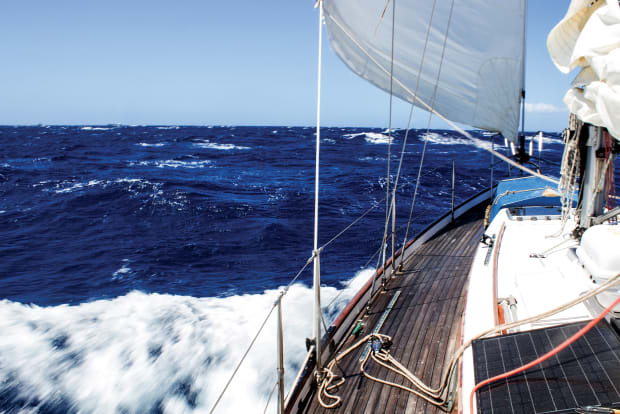
Photo by Ellen Massey Leonard
We didn’t get off on the right foot sailing into Hawaii. It was our own fault, of course. We should have known better. It’s never a good idea to assume that just because procedures were a certain way one year, they will be the same the next. It was an especially bad idea given the world was still in the middle of the Covid-19 pandemic. Nonetheless, “Go away!” shouted through a megaphone, didn’t seem like the most constructive way of handling the situation.
Not to say my husband, Seth, and I was entirely surprised. Having lived in the islands for a number of years now, we knew sailors often don’t get much of an aloha from the authorities in this part of the world. We also knew the reasons for this attitude, having heard the stories of sailors being polluters, creating eyesores both above the surface and sewage below, as well as sailors who contribute nothing to the economy while making use of the state’s infrastructure and paying no taxes. Then there are that handful of entitled cruisers who have behaved rudely to local officials over the years, sealing the deal, as it were. The result is a kind of official obstruction to sailing here, as well as poor services for boaters, both local and transient, which is a shame. Hawaii has one of the greatest seafaring histories in the world, and yet it’s very difficult even for locals to cruise the islands. One of our good friends—a Native Hawaiian, no less—was recently run out of an anchorage on the island of Lana`i with no reason given. The official antagonism toward cruisers is all the more bizarre because the rest of the people who live here don’t seem hostile to sailors at all.
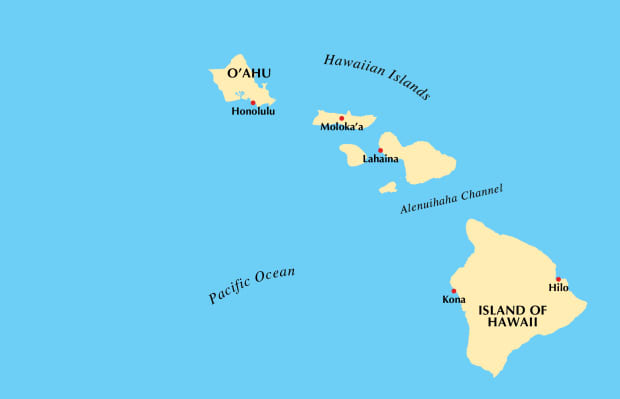
Knowing all this, and despite being Hawaiian residents, Seth and I had decided against sailing directly home when we’d left North America aboard our cold-molded sloop, Celeste, deciding instead to sail to French Polynesia—an area we had both wanted to go back to ever since our circumnavigation a dozen years earlier.
At that time, we hadn’t had much of a plan beyond French Polynesia. But then the pandemic hit, and borders across the South Pacific began closing. Given the uncertainty in the world, we decided it might be best if we sailed Celeste back home after all, and toward the end of 2020 hoisted sail and set off on the same route north countless Polynesia sailing canoes had plied in centuries past.
The passage wasn’t an easy one, as we encountered mostly headwinds (see Close-hauled to Hawaii, Sept. 2021 issue). Nonetheless, after nearly 20 days at sea, we reached the island of Hawaii, affectionately known as the “Big Island,” in thickly overcast weather. Another day or so after that found us rounding the breakwater into Hilo Bay.
We knew, or thought we knew after having helped a few of our sailing friends with their arrivals, that the correct procedure for sailboats arriving from foreign waters was to moor in Radio Bay. Radio Bay is a manmade rectangle with a mud bottom in the far corner of the port, perfectly protected. It’s large enough to accommodate a number of vessels, especially when stern-tied to the seawall and has served as the bay’s small boat basin for decades.
Unfortunately, unbeknownst to Seth and me, the Department of Transportation had decided in the spring of 2020 to close Radio Bay to transient vessels, most likely in response to those cruisers who had arrived there early in the pandemic and then violated quarantine. I can understand the frustration of the offending cruisers. They had already been at sea for at least two weeks and had therefore already effectively quarantined. However, a 14-day quarantine had been the rule, and they had known that ahead of time, so violating it was neither very smart nor very considerate. Worse yet, for Seth and me, the result as we puttered into Radio Bay at 0200 on a Saturday morning—in complete darkness and a torrential downpour—was to be greeted by the aforementioned order: “Go Away!”
Again, the fault was ours, but that didn’t make the situation any less unpleasant. Although we’d double checked the state’s covid regulations prior our departure, we had not thought to check its other entry procedures, a complacency born out of being Hawaiian residents. Tired, confused and a little bit angry—we were returning home, after all—we shouted back through the rain asking where we should go. Our interlocutor, however only seemed to have those same two words at his disposal.

“Where should we go?” we kept calling until the next thing we knew Megaphone Man had disappeared. Ten minutes later he was back, accompanied by another man with a megaphone. Someone really should get these people radios, Seth and I grumbled to one another; however, this second person provided a good deal more helpful as he was able to tell us what to do, and so we puttered out again into the enormous arc of Hilo Bay toward an indent in the shoreline known as Reed’s Bay, a significantly more exposed place to drop the hook. Fortunately, there was little wind that night. At long last, after setting the anchor, we fell into bed.
When we woke the next morning, the sun was shimmering on the blue water of the bay and sweeping its light and warmth up to the very top of nearby Mauna Kea. The red slope of the 14,000ft mountain rose into a brilliant sky, devoid of clouds. The air was fresh and cool. The difficulties of the night before quickly faded under the influence of the scene before us.
Seth and I kept Celeste in Hilo for as long as we were permitted under the state’s transient boat regulations. Eventually, though, it came for us to continue on to O`ahu, where we’d arranged a permanent marina slip for Celeste in which she would be free of the various restrictions on transient vessels. We also had a number of work projects we planned on doing there after our years in French Polynesia, where boat parts are expensive and hard to find. Although we wouldn’t be able to take the time for any kind of an extended cruise, we still planned on making a few stops along the way, including a kind of pit stop for a quick haulout in order to put on the fresh coat of much-needed bottom paint.
We began the trip at 0200, leaving Hilo in darkness, the same as when we had come, although this time we had clear skies. It was calm, but the wind was forecast to build at sunrise. As we puttered north along the darkened coast, the sky eventually lightened enough that we could make out Mauna Kea climbing up into the stars. Gradually the sun spilled down the mountain’s flanks, touching the peak first and then the mountain’s upper slopes before reaching the sea and Celeste, as we continued on past the great green canyons of Waipio and Waimanu valleys, immense river valleys with nearly vertical sides and waterfalls tumbling many hundreds of feet from the plateau above to the valley floor.
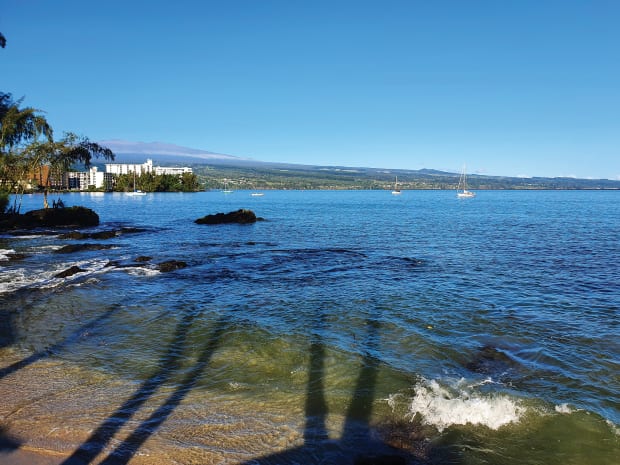
Photo by Ellen Massey Leonard
As forecast, the wind soon began to build, and Celeste gathered speed under full mainsail and genoa, as we flew past the last of the lush valleys ashore to where the land again gently sloped toward the sea. Soon a reef was needed in the mainsail, then two and finally a third as we came entered the Alenuihaha Channel, which separates the Big Island from the 10,000ft peak of Haleakala on Maui, accelerating the trade winds funneling through and kicking up big seas. Fortunately, we were running before the wind, so the ride was fast and exhilarating.
Turning the corner to run down the leeward side of the Big Island, the wind lessened and the land was suddenly brown and dry, a desert shielded by the mountains to the east from the rain clouds that pile up on these same mountains’ windward faces. Right where we expected it, we sailed across the wind line and into a dead calm in the lee of Mauna Kea. By midday, or even earlier sometimes, a seabreeze will kick in. But it was still too early for that kind of thing at the time we got there.
A short putter down the coast brought us to Kawaihae Bay. However, we couldn’t stay long, as Hawaii has an anchoring policy of only 72 hours in each “zone,” and a single zone can cover 50 miles of coastline. We therefore continued on toward Anaeho`omalu Bay, a decently protected spot a little farther along. Accompanying us now after our stop in Kawaihae Bay was the same friend who had been kicked out of that anchorage on Lana’i. All three of us belong to the same outrigger canoe paddling club, and he said his hope was that we could make the club’s sailing canoe seaworthy again.
A few hours later, we were nosing our way into Anaeho’omalu Bay, with Seth on the bow keeping an eye out for coral. The seabreeze was strong here, and there were a number of kitesurfers out, including some on foiling boards. One of them maneuvered up under our stern and called out that he was the captain of one of the local resort catamarans and pointed out where we should go.
Eventually, our friend had to return home, after which Seth and I stayed another day, enjoying the snorkeling in the calm water in the area of a nearby coral reef and enjoying a meal ashore at the Lava Lava Beach Club, complete with live music and mai-tais. All too soon, though, it was time to go, in order to keep our appointment for our haulout at the Kona boatyard.
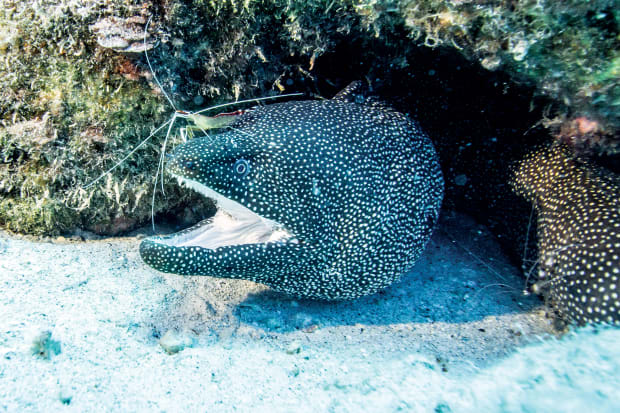
Photo by Ellen Massey Leonard
As our request over the phone for a transient slip in the Kona harbor had been denied, we made a dawn start the next day and had another pleasant sail in steady winds down the coast, Mauna Kea (13,803ft), Mauna Loa (13,679ft) and Hualalai (8,271ft) all silhouetted against the rosy eastern sky along the way. We reached Kona right on time. However, the Travelift was delayed, and so we ended up picking up a dive mooring outside the harbor to wait. While we were there we passed the time diving on another vibrant coral reef, alive with schools of goatfish, moray eels and a few big sea turtles. It wasn’t long before a pod of spinner dolphins arrived, swimming close to get a good look at us. Any amount of officialdom is worth a moment like that!
We spent the next few days bottom-painting Celeste and also made a new friend: a man who runs a charter operation on Maui. He didn’t surprise us when he said that we would almost certainly be denied a transient slip on Maui, too, and that anchoring wasn’t ideal due to funneling winds and lack of protected bays. However, he also offered us use his marina slip, as he wouldn’t be back for another week at least. This generosity meant we had a wonderfully relaxed time on Maui.
By stopping once more in Kawaihae Bay before making the trip across Alenuihaha Channel, we were able to time things for the best forecast that week and never saw more than 30 knots on the beam. The waves were also mild for the channel, so we had a speedy and manageable crossing, right up until we came under the lee of Haleakala where the wind died again.
After that, we sailed past Kaho`olawe, a low, reddish island that was once used for bombing practice by the military, and then started the engine again between Maui and Lana`i. We also passed the islet of Molokini, one of the best snorkel and dive sites in the state, although the islet was off-limits at the time because a snorkeler had tragically been lost there and search-and-rescue operations were still in effect.
Eventually, we turned up into Maalea Bay, which is when the wind built again. Funneling winds for sure! Maalea Bay is the eastern end of the low saddle between East Maui, where Haleakala rears up 10,000ft, and West Maui, which is also quite mountainous, and we had a hard beat to reach the harbor in the bay’s northwest corner. We finally made it as evening was coming on, and quickly found the slip belonging to our kind acquaintance at the Kona boatyard. Another sailor in the harbor helped us make fast to the pier in the high winds.
As we only had four days before the slip would be needed again by its owner, we rented a car to see as much of the island as we could. As we were doing so we hiked up rivers and ridges, along the tops of green valleys reminiscent of the Marquesas, and even bushwacked up a hillside to the overgrown ruin of an old heiau, or ancient Hawaiian temple. We also slipped into clear water full of coral and came upon two octopus swimming out in the open above their reef. We watched as they settled toward the coral where I wasn’t sure at first whether they were fighting or mating, although after a little research online, I’m pretty sure it was the latter.
Our last evening on Maui we visited the old whaling town of Lahaina, where we strolled along the waterfront until we found the Lahaina Yacht Club. Sitting at a table in the little hole-in-the-wall building, burgers and beers before us, we watched the sun go down over the boats at anchor in the roadstead. The evening light was pouring through the burgees of countless yacht clubs from around the world, burgees brought back to Lahaina by members of the club. We tried to pick out the ones we had been to.
For both of us, the evening felt like a throwback to an earlier era before the pandemic, before social media and even chartplotters, back when swapping tales at little spots like this was the primary way sailors exchanged news and advice. We both found ourselves growing nostalgic for the time when we’d sailed around the world on our first boat, a boat that may have been primitive, but was sturdy and seaworthy as well. We’d been to so many cozy little sailing clubs like this where we’d inevitably ended up making all kinds of friends. No one was ever filming anything or posting anything online. It had just been a bunch of like-minded sailors all having a good time together, all giving generously of their knowledge or skills. The cruising community had felt so tight-knit back then, and had been so much fun.
Over the years Seth and I have continued voyaging, we’ve both begun to feel the sailing community has become less of a community than what we encountered on our circumnav. This little spot, though, felt so much like the many cruiser hangouts we’d frequented in the past it couldn’t help but lift our spirits, as it seemed the community here was as generous and tight-knit as ever, making it an especially satisfying port of call.
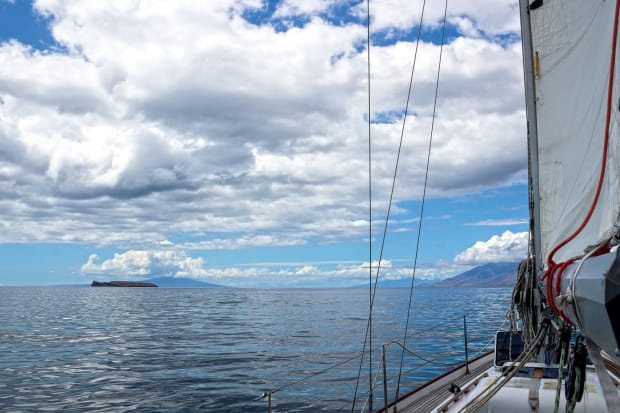
Photo by Ellen Massey Leonard
Unfortunately, while neither of us wanted to leave, neither did we want to roll at anchor in that open roadstead when our time in our friend’s slip had ended. So off we headed again, making the crossing between Maui and Moloka’i in what proved to be the toughest stretch yet, with plenty of wind and confused seas. On the plus side, the view of Moloka’i’s steep shoreline with its many waterfalls was stunning, and by late afternoon we’d succeeded in reaching the protection of an abandoned harbor where we spent a peaceful night at anchor.
The next morning we made the crossing to O’ahu, which proved to even tougher than the leg to Molokai’. Tearing along at 8 knots through the water, we were only able to make 6 knots over ground to the tide, which was also causing the waves to build up into steep, choppy whitecaps. We had set a couple of fishing lines before getting into the worst of it, but of course the fish didn’t bite until we were getting truly slammed. Somehow we not only managed to land a good-sized mahi-mahi, but Seth even managed to somehow fillet it on the pitching deck.
Eventually, we found ourselves reaching past the high rises of Waikiki, and by evening were safe and sound in the marina that was to be Celeste’s new home. Relaxing in the cockpit as the sun went down, savoring mahi-mahi sushi rolls, we realized for the first time in what felt like ages we didn’t have to worry about where to go next. There was, finally, no one who was going to tell us we had to move along. We were home!
July/August 2022








